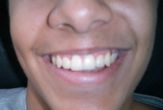Nuclear Tests Leave Mark in Teeth, Reveal Age

Aboveground testing of nuclear bombs during the 1950s and 1960s produced large amounts of radioactive carbon that diffused around the globe. One of the places this radioactive element ended up is in our teeth, a new study reports.
Carbon 14 (C14) is a radioactive form of carbon that makes up approximately 0.001percent of the total amount of naturally occurring carbon on Earth. Beginning in 1955, the global concentration of C14 in the atmosphere spiked due to increased nuclear bomb testing taking place in various countries worldwide, including the United States.
C14 acts just like regular carbon and can react with oxygen to form carbon dioxide. Plants incorporate the radioactive carbon dioxide by photosynthesis. By eating plants and the animals that feed on plants, the C14 concentration in the human body closely parallels that in the atmosphere at any given time.
One place in the human body where carbon is incorporated is in the teeth, where it makes up approximately 0.4 percent of the hard outer covering of the tooth known as the enamel. During childhood, the enamel forms at different times depending on the tooth and is laid down only once. The final formation of enamel occurs at age 12 in a child's wisdom teeth. This means that the C14 concentration found in the enamel of the tooth reflects the amount of C14 that was in the atmosphere when the enamel formed.
Between 1955 and 1963, approximately 160 nuclear bombs were detonated aboveground in the United States. With the signing of the Limited Test Ban Treaty in 1963, nuclear testing in the United States, Great Britain and Russia moved underground and atmospheric concentration of C14 have since been dropping exponentially due to radioactive decay and atmospheric diffusion.
One Morbid Use
This knowledge is proving particularly useful for forensic scientists because it provides them with a new method of determining a person's age at death that is more accurate than traditional methods.
In their study, the researchers were able to determine the ages of 22 individuals to within 1.6 years by comparing the amount of C14 in their teeth to the known concentrations of C14 in the atmosphere.
Sign up for the Live Science daily newsletter now
Get the world’s most fascinating discoveries delivered straight to your inbox.
Currently, the most commonly used method for determining an individual's age at death is to look for signs of wear in the individual's teeth or in the skeleton, said Jonas Fris?n, a biologist at the Karolinska Institute in Sweden and principal investigator of the study. In adults, however, this method is only accurate to within 5-10 years.
Because scientists know that teeth generally grow from the front to the back of the mouth, they can figure out whether an individual was born before or after 1963--the peak of nuclear testing--by comparing the concentration of C14 in the newer teeth versus that of the older teeth.
Because atmospheric C14 concentrations began to rise only in 1955, the technique does not work for individuals born before 1943--twelve years before worldwide levels of C14 began to increase--since all their teeth would already have formed by this time.
Fris?n told LiveScience that the method has been used to by the Swedish police to determine the age of some of the victims if the recent tsunami in Southeast Asia.
The method should work for people living all around the globe, regardless of race or ethnicity, since atmospheric diffusion should have evenly distributed C14 around the globe. While it's conceivable that differences in diet or in local conditions might lead to variability in the amount of C14 incorporated into tooth enamel, other studies suggests this is unlikely.
?
Fris?n believes the method should be useful for several more decades since global atmospheric concentrations are decreasing only slowly and C14 measurement techniques continue to improve.
- By Ker Than










